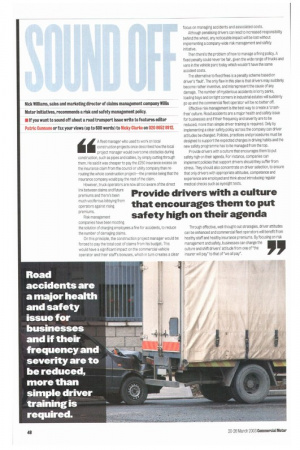ono * - 40 poo woo moo* tool ii
Page 48

If you've noticed an error in this article please click here to report it so we can fix it.
Nick Williams, sales and marketing director of claims management company Willis Motor Initiatives, recommends a risk and safety management policy.
• if you want to sound off about a road transport issue write to features editor Patric Cunnane or fax your views (up to 600 words) to Micky Clarke on 020 8652 8912.
ii construction fleet umcat i manager gperrowj projects su onces e d t od ewsocrrkboendl oh co awl
the local project manager would overcome obstacles during construction, such as pipes and cables,by simply cutting through them. He said it was cheaper to pay the £250 insurance excess on the insurance claim from the council or utility company than rerouting the whole construction project—the premise being that the insurance company would pay the rest of the claim. However, truck operators are now all too aware of the direct
link between claims and future premiums and there's been much vociferous lobbying tic" operators against rising premiums.
Risk management companies have been mooting the solution of charging employees a fine for accidents, to reduce the number of damaging claims. On this principle, the construction project manager would be forced to pay the total cost of claims from his budget. This would have a significant impact on the commercial vehicle operator and their staff's bonuses, which in turn creates a clear focus on managing accidents and associated costs. Although penalising drivers can lead to increased responsibility behind the wheel, any noticeable impact will be lost without implementing a company-wide risk management and safety initiative. Then there's the problem of how to manage a fining policy. A fixed penalty could never be fair, given the wide range of trucks and vans in the vehicle parc today which wouldn't have the same accident costs. The alternative to fixed fines is a penalty scheme based on driver's 'fault'. The only flaw in this plan is that drivers may suddenly become rather inventive. and misrepresent the cause of any damage. The number of mysterious accidents in lorry parks, loading bays and on tight corners in industrial estates will suddenly go up and the commercial fleet operator will be no better off. Effective risk management is the best way to create a 'crashfree' culture. Road accidents are a major health and safety issue for businesses and if their frequency and severity are to be reduced, more than simple driver training is required. Only by implementing a clear safety policy across the company can driver attitudes be changed. Policies, practices and procedures must be designed to support the expected changes in driving habits and the new safety programme has to be managed from the top. Provide drivers with a culture that encourages them to put safety high on their agenda. For instance, companies can implement policies that support drivers should they suffer from stress. They should also concentrate on driver selection, to ensure that only drivers with appropriate attitudes, competence and experience are employed and think about introducing regular medical checks such as eyesight tests.
Through effective, well-thought-out strategies, driver attitudes can be enhanced and commercial fleet operators will benefit from healthy staff and healthy insurance premiums. By focusing on risk management and safety, businesses can change the culture and shift drivers' attitude from one of "the insurer will pay" to that of "we all pay".








































































































































































